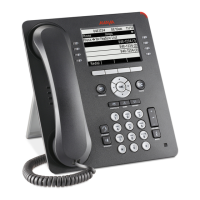About the user interface/failover experience
Issue 3 January 2014 165
(including drop last party). Additional in-call features will be available if supported by the
local proxy - find me, inbound call management and outbound call management.
● Contact or Autodial Favorite Features are displayed on the Phone Screen.
● Presence is not supported.
● "A" (Avaya) Menu and Home Screen Options & Settings are blocked under minimal
survivability configurations. Any of the more extensive survivability configurations (for
example, moving subscriptions to a secondary Session Manager/BSM for simultaneous
registration) allow access to the Avaya Menu and updates to Options & Settings. Likewise,
Contacts can be accessed and updated.
● Craft changes may be made and are saved locally on the deskphone.
● If the deskphone is logged out during failover, the local deskphone cache is cleared.
User experience during failback
Failback (F/B) transition occurs when the deskphone detects that the primary server is up,
regardless if secondary controller is up.
● Failback will not happen during an active call. If no calls are in progress, failback occurs
and the user interface returns to its normal appearance.
● While switching from one server to another (including while waiting for an active call to
end) reject any new inbound calls (including emergency callbacks) or outbound call
requests.
● AST features return.
● Pre-failover Visiting User status maintained after failback.
● Users can access and update Avaya Menu/Home Screen options.
User interface failover operation for features
Feature Normal Operation with
Communication
Manager
Failover Operation with a
Generic SIP Gateway
Make call Yes Yes
Receive call Yes Yes
Call Hold Yes Yes

